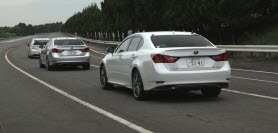 The race to introduce an autonomous-driving car is on. Nissan recently targeted 2020, while Audi and General Motors have also said they will each have a fully self-driving car on the market by the end of the decade. Google has said it expects to produce autonomous cars by 2017, although it’s unclear whether the tech giant will partner with an automaker or go it alone.
The race to introduce an autonomous-driving car is on. Nissan recently targeted 2020, while Audi and General Motors have also said they will each have a fully self-driving car on the market by the end of the decade. Google has said it expects to produce autonomous cars by 2017, although it’s unclear whether the tech giant will partner with an automaker or go it alone.
Now Toyota, which unveiled a prototype self-driving Lexus at last year’s Consumer Electronics Show, has announced two new autonomous technologies that it says will be available “in the mid 2010s.” Cooperative-adaptive Cruise Control lets the host car maintain its speed relative to vehicles in front using vehicle-to-vehicle (V2V) communication (shown above), while Lane Trace Control keeps it centered in its lane.
Together they’ll lead to autonomous highway driving, according to Toyota.
Unlike regular adaptive cruise control (ACC) that uses radar to detect vehicles ahead, Cooperative-adaptive Cruise Control uses V2V communication to transmit acceleration and deceleration information between cars to moderate their speeds and automate driving. A Toyota spokesperson told MSN Autos that both vehicles would need to have V2V communication capability, and if they do not “it functions as standard adaptive cruise control.”
Like existing driver-assist technologies such as ACC and collision prevention systems, Lane Trace Control uses cameras, radar and software to keep a car in its intended lane “at all speeds,” according to Toyota. The system will also regulate the vehicle’s steering angle, driving torque and braking force to “maintain the optimal line within the lane,” Toyota said in a statement. The automaker will begin testing the features on Japan’s Shuto Expressway near Tokyo starting next week.
Toyota also announced it has developed a version of its existing Pre-collision System (PCS) that, in addition to automatic braking, uses automatic steering to help prevent collisions with pedestrians. Last year, Toyota introduced an update of PCS that employs automatic braking to help prevent pedestrian collisions if a driver doesn’t heed audible and visual warnings, and included it on the latest LS models.
The new PCS with Pedestrian-avoidance Steer Assist helps avoid collisions “in cases where automatic braking alone is not sufficient, such as when the vehicle is traveling too fast or a pedestrian suddenly steps into the vehicle’s path,” Toyota said in a statement. Toyota added that its goal is to make PCS with Pedestrian-avoidance (but without automatic steering) available on more models by 2015 before rolling out PCS with Pedestrian-avoidance Steer Assist.
[Source: Toyota]
Source: MSN
No comments:
Post a Comment